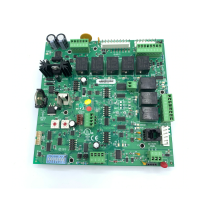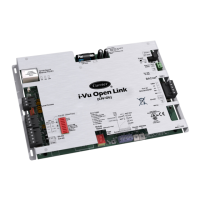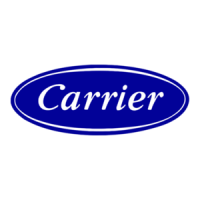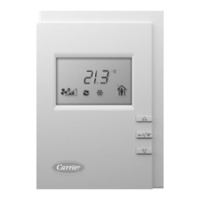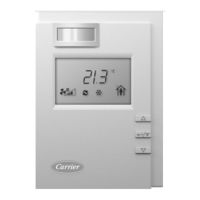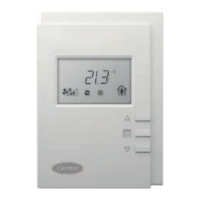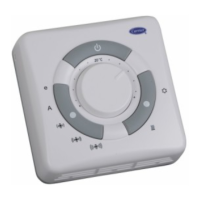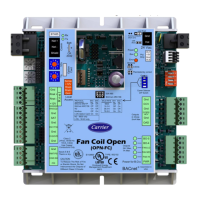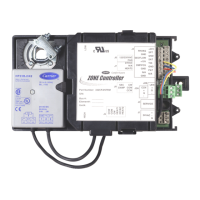25
space at the user configured differential set point. The set point
is the difference between the indoor air quality and an optional
outdoor air quality sensor. If the outdoor air quality is not pres-
ent then a fixed value of 400ppm is used. The following condi-
tions must be true in order for this algorithm to run:
• The mode is occupied.
• Indoor Fan is ON.
• Indoor Air Quality is a valid reading.
As air quality within the space decreases, the minimum posi-
tion of the economizer damper will be increased thus allowing
more outdoor air into the space depending on the relationship
of the indoor air quality to the differential setpoint. If all the
above conditions are true, the IAQ algorithm will run and cal-
culates an IAQ minimum position value using a PID loop. The
IAQ minimum damper position is then compared against the
user configured economizer minimum position and the greatest
value becomes the final minimum damper position of the econ-
omizer output.
If the IAQ minimum position calculated by the control is great-
er than the DCV Max Vent Damper Pos configured, then it will
be clamped to the configured value.
Dehumidification
The RTU Open controller will provide occupied and unoccu-
pied dehumidification only on units that are equipped with the
Humidi-MiZer
®
option from the factory. This function requires
a space relative humidity sensor or a humidistat for control.
The space relative humidity senor can be installed and config-
ured as one of the two analog input channels (inputs 1 or 2 on
J4), or a humidistat can be installed and configured as switch
input 9 on J5 (except on units configured as LC WeatherEx-
pert
®
with gas heat). When using a relative humidity sensor to
control dehumidification, occupied or unoccupied dehumidifi-
cation setpoints are use accordingly. When using a humidistat,
setpoints are not used and the dehumidification call comes
when the humidistat indicates high humidity.
When the indoor relative humidity becomes greater than the dehu-
midification setpoint (or switches from low to high), a demand for
dehumidification demand is identified. Compressor state is moni-
tored and time guards are honored. If a compressor was just turned
off prior to the dehum call the dehumidification output will be de-
layed the 5 minute minimum off time of the compressor. When ok
to dehumidify, the dehumidification output (J11-7, 8) will be ener-
gized. This will bring on the supply fan (at high fan speed if Fan
Control is set to “Two Speed” or “Variable Speed”), all compres-
sors, and the dehumidification relay placing the unit in Hot Gas
Reheat dehumidification mode. If dehumidification is called for
during cooling or cooling is called for during dehumidification,
the unit will run in Subcooling dehumidification mode. Individual
unit circuits can be in different dehumidification modes based on
the demand. Refer to the base units operation for additional infor-
mation.
NOTE: There is a fixed 5% hysteresis that the indoor relative hu-
midity must drop below the active setpoint to end the dehumidifi-
cation mode and de-energize the dehumidification output. The
output will also de-energize if the fan relay is de-energized.
Demand Limit
If the RTU Open controller receives a level 1 (one degree off-
set), 2 (two degree offset), or a 3 (4 degree offset) to the BAC-
net demand limit variable, the controller will outwardly expand
the heating and cooling setpoints by the configured demand
limit setpoint value and remain in effect until the BACnet de-
mand limit variable receives a 0 value.
Unoccupied Free Cooling
When the unit is equipped with an economizer, the control can
run a night time free cooling (NTFC) mode called Unocc Free
Cooling. In this mode the damper is utilized to bring in outdoor
air for free cooling during unoccupied periods. The following
conditions must be true for unoccupied free cooling to operate:
• Unocc Free Cool Enable set to Enable
• The system is unoccupied
• The outside air temperature is below the Economizer High
OAT Lockout Temp
• The outside air temperature is less than the space temperature
• Enthalpy (if enabled) is Low
When the RTU Open controller’s schedule is unoccupied and the
space temperature rises at least 1 degree above the Occupied
Cooling Setpoint, the supply fan starts. The economizer damper
opens as necessary to cool the space. The RTU Open controller
continues to operate in this mode until the space is satisfied or the
outside air conditions are no longer suitable for free cooling.
Optimal Start
The RTU Open controller may utilize either of two different
optimal start types. Temperature Compensated start is designed
specifically for LC units in order to minimize fan operation.
Temperature Compensated Start changes the setpoint from the
unoccupied setpoint directly to the Occupied setpoints at a cal-
culated time prior to occupancy in order to achieve the occu-
pied setpoint at the scheduled occupied time. Learning Adap-
tive Start adjusts the effective setpoints to achieve the occupied
setpoints by the time scheduled occupancy begins. The Learn-
ing Adaptive algorithm works by moving the unoccupied set-
points toward the occupied setpoints. The rate at which the set-
points move is based on the outside air temperature, design
temperatures, and capacities. The Optimal Start recovery peri-
od may begin as early as 4 hours prior to occupancy. To disable
Optimal Start, set the optimal start type to None. The following
conditions must be true for optimal start to operate:
• Under SETPOINT, Optimal Start Value must be set greater
than zero
• The Optimal Start type must not be None
• The system is unoccupied
• The RTU Open controller has a valid outside air temperature
• The RTU Open controller is running occupancy based on a
local occupancy schedule, where next time occupied is
known.
Fire Shutdown
Fire Shutdown may be configured on Binary Input 5. A typical
application involves a smoke detector or fire shutdown contact,
which, when active, immediately shuts down equipment
operation.
Compressor Safety
Compressor Safety may be configured on Binary Input 3. This
feedback can be provided by a Compressor Lock-Out (CLO)
device or current switch when field installed. A Compressor
Safety Alarm indicates that the equipment requires attention.
Cooling, heating, and supply fan outputs are not interrupted.
Normal operation resumes when the compressor safety circuit
is de-energized.
Fan Status
Fan Status may be configured on any unused binary input
channel. A typical application would be an airflow switch, cur-
rent sensing relay, or other device that provides a supply fan
running verification. Enabling this function displays the supply
fan's status on the equipment graphic. If the controller loses fan
status during operation, heating and cooling are disabled, the
economizer damper (if available) is closed, and an alarm for
loss of status is indicated. If the fan status is on when the con-
troller is commanding the fan off, the unit remains in the off
state. An alarm is generated indicating that the fan is running
when it should be off.

